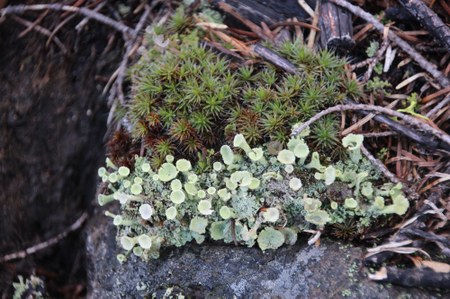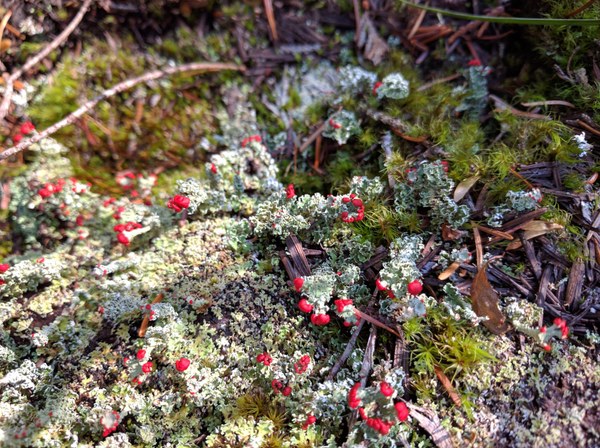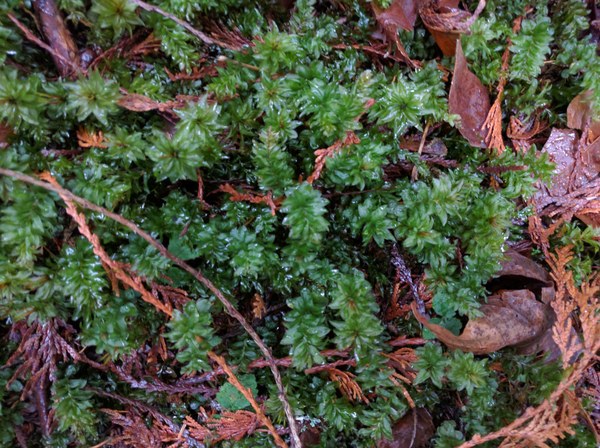
by Gordie Swartzman, Stewart Hougen and Gary Brill
As the mountains brighten with a blanket of fresh white on its highest hills, and evening alpenglow illuminates the distance with shades of pink and orange, we are allured by snow: tossing on snowshoes and skis to venture into the fantastic. Naturalists, searching for flora and fauna, turn to the foothills — and their manuals. We flip past the names of flowering meadow plants, summer mammals and autumn berries. We're reminded of the little things that flourish year-round in the temperate rainforest that makes up the Pacific Northwest — and especially in its wettest seasons — moss and lichen.
Ensconced in the winter with our books, our events and our reflections, we do not notice the subtle transformations occurring in our woods. While the mountains are covered in snow, the lowlands become blanketed with mosses and lichens that burgeon on branches of deciduous trees and shrubs. For them, this is the time of growth, of light, and of reproduction. They make hay while the rains reign.
Mosses and lichens have an ancient pedigree. Evolutionarily, they predate all other land plants. They are the simple organisms we’ve all seen growing on trees and rocks. Mosses have the most basic of root structures, leaves, and stems. Lichens are quite different: a composite organism, created from a joining of algae and fungus.
Mosses are one of the most primitive types of plants, and their simple structures have remained largely unchanged over the course of millions of years. Thought to have evolved from green algae, mosses are characterized by their simple root structures, stems, and leaves. There are around 14,500 different types of mosses, and because of their simple structure and low nutrient requirements, they will often be found thriving in places that other plants can’t grow.
Both mosses and lichens can dry out completely and even become brittle, but when water returns, they completely reconstitute and remain viable. In fact, pieces of brittle lichen can blow off and form completely new lichen, which explains many lichens' large range distribution.
A Closer Look at Lichen
Lichens can very easily be mistaken for mosses, but lack the stems and leaves of the moss. Lichen are divided into four main groups based on their appearance: the foliose, fruticose, crustose and leprose lichens.
Foliose (leafy) lichens are perhaps most commonly mistaken for moss. They form flat, circular, rosette patterns on the rocks and trees that they adhere to, and grow structures that can easily be mistaken for leaves. Similarly, fruticose lichens have a shrublike, leafy appearance (in miniature), although they grow in height as well as area. These shrubby lichens are usually found on trees rather than rocks.
The leaf-like structures in lichens aren’t actually plants, though, they’re fungus. Other structures that might be responsible for holding the lichen onto whatever surface it has attached to are algae, making the composite structure of the lichen.
 Cladonia lichen. Photo by Gordie Swartzman.
Cladonia lichen. Photo by Gordie Swartzman.
The other two types of lichens—the crusty, flat, crustose lichens and the patchy, powdery, leprose lichens are much easier to recognize as being a growth completely separate from mosses. These two types of lichen clearly lack any kind of leaf-like structure and are more closely likened to the appearance of rust or other grainy crust.
Mosses and Mycorrhiza
The leaves and stems of mosses are generally tiny; it can be difficult to tell the difference between them at a glance. Some mosses have leaves that are so tiny that a magnifying glass might be needed to tell what they look like.
Both mosses and lichens can sexually reproduce. Mosses produce spores from female and male plants and these must be water dispersed, which makes them require being near water for at least part of their lives. Lichens produce spore bearing bodies called apothecia, which can be dispersed by air, but require the spores to have both an algal and a fungal piece. The complexity of this association suggests lichens' long pedigree, and is also reflected in the association that many plants have with fungi (called mycorrhizal associations and informs the association of many mushroom species with specific types of trees).
The wonder of it all is that these processes occur under our very noses and without us paying them the least mind. However, take a walk in the woods, along a stream or near rocky bluffs during a wet period and you will note the profusion of green in many subtle tones and hues.
Anyone who has walked in the Hoh Rainforest or along the Wallace Falls trail in the winter or spring knows they are in a rainforest because of the proliferation of mosses, seemingly everywhere. Much of this moss, seen hanging from almost every overlying branch is the cattail moss. For us, moss signifies the forest and filters and softens the light of winter, giving it an air of a cathedral. Moss blanketing the trees invites us to hug the trees. Mosses, besides beckoning us into the deep woods, also create a sense of protection. Mosses are ancient, far outdating the trees they grow on. They are alive; they are moist; they are accessible. They form the basis of early soil development as they colonize rocks and bare spaces. They use the filtered light and water runoff and convert it into life. They hold the water in the ecosystem. And they have given us one of our most productive growing substrates: peat, a boggy, nutrient-rich soil made of partially decomposed vegetable matter.
Mosses feed the naturalists desire for learning about our natural systems in the winter because they are there. Looking at them through a magnifying loupe we are astounded at their beauty and complexity of form. They are as thick as any flowering meadow and have varied forms and habitats. Their identification is more like the 1000 piece than 100 piece puzzles, since they can be cryptic and there are many species. However, armed with a magnifier and time for reflection, we can learn to tell the more common species apart. And, like many ecosystems, a small number of species form the majority of all mosses in any region. Thus, within a short period the beginner can identify over 80% of the mosses they look at — and they are easy to find. They often cover almost all the bare ground and tree trunks and branches in an area.
 Badge moss. Photo by Gordie Swartzman.
Badge moss. Photo by Gordie Swartzman.
While mosses dominate the winter forest-scape, trees, rocks and ground lichens are proliferating on the upper branches, particularly on deciduous trees. As such, most lichens are too high in the canopy to be seen, except, thanks to high winds and storms, many lichens get knocked to the ground, usually attached to branches. This allows us to study them, usually seeing several species on a single branch, making every branch an adventure.
Exploring Nature
The Mountaineers Naturalist Group has workshops year-round. Our winter-time moss and lichen workshops involve lectures that give keys to classes (groups) of mosses and lichens, their evolution, life history and ecological niche, and how to identify them. There are in-class identification exercises and field trips. Repetition and practice form the basis for learning.
Every spring, we offer an Introduction to the Natural World class that runs April-July. If the mosses and lichens workshops are seen as a close look at a niche subject, the Intro course could be seen as a broad brush painting of a large set of biota. The format involves lecture introductions on geology of the northwest, life zones, conifers, ferns, flowers, birds, insects, butterflies, seashore life, and specific ecosystems visited during accompanying field trips. We use field guides, web pages, and smart phone/pad apps to make this study easier. We also use our native plant garden, adjacent to The Mountaineers Seattle Program Center in Magnuson Park, as a learning laboratory.
You don't need to be an expert to appreciate the natural world, but knowing the names and subtle differences does make the world a little more inviting to explore.
Find out more about the natural world through one of our courses, clinics, and seminars, or through one of our Exploring Nature activities.
This article originally appeared in our spring 2017 issue of Mountaineer Magazine. To view the original article in magazine form and read more stories from our publication, click here.
 Gordie Swartzman
Gordie Swartzman